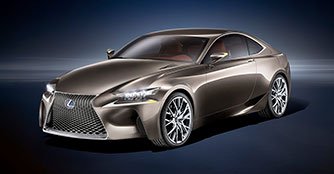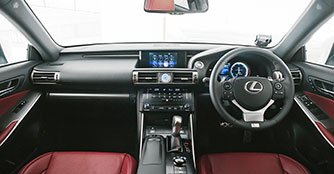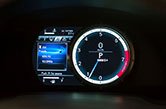Lexus IS250 2.5 F Sport (A) Review
05 Aug 2013|42,474 views
Quality and reliability have always been the foundation Lexus builds on. But these two said traits do not necessarily equate to an exciting car or drive. It's probably as much fun as playing fetch with your pet dog at a park while sucking on your beer bottle.
But things have changed a fair bit since last year when the luxury Japanese brand decided to add some excitement to its product lineup and introduced the new face of Lexus, dubbed the spindle grille, starting with the GS models.
Now, the Lexus IS has arrived and while the car has been known to have styling changes that were merely minor, it's high time to pay attention.
Unveiled in October at the 2012 Paris Motor Show, the LF-CC (Lexus Future-Compact Coupe) was a concept car that gave the world a preview of the next generation IS. And it wasn't until January 2013 when the production-ready Lexus IS was revealed at the North American International Auto Show.
Exterior
On first glance, the Lexus IS250, equipped with the F Sport kit (as what you see here), is indeed aggressive.
Thanks to the most obvious change, the gaping spindle grille, which sports a black mesh (on F Sport only), you are bound to notice the car as it bears down on you on the highway. Flanking the threatening grille are the curvy headlights and separated arrowhead LED running lights that mimic the LF-CC concept.
 |
This is by far, perhaps, Lexus' most successful and comprehensive attempt in creating a styling language that are both exciting and unique to the brand and segment. That's, of course, needless to say that for such a powerful design, the styling of the new Lexus may raise some eyebrows, landing itself in the 'love it or loathe it' zone.
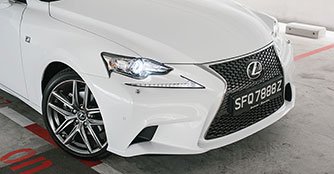
At 1,555kg, the car has lost some 10kg but has grown in size. Measuring 4,665mm x 2,027mm x 1,430mm (L x W x H), the compact sedan is 75mm longer, 10mm wider and 5mm taller compared to the previous model.
Thus, if the Japanese brand was going for more eyeballs and presence, there's absolutely no denying that it has succeeded with the car here.
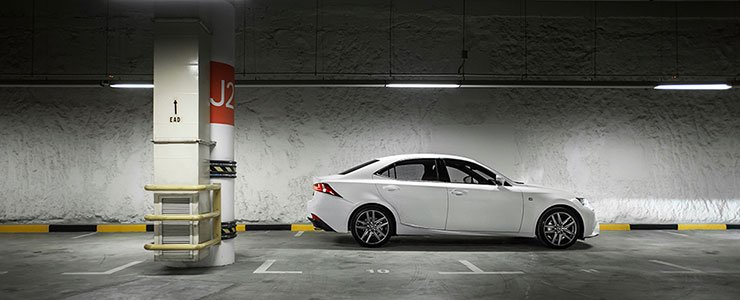 |
Interior
This is where Lexus tops the charts. It's certainly a nice place to be in, all thanks to the abundance of soft leather materials and quality stitching. Coupled with the fact that fit and finish is of the highest quality ever to be seen in its segment, the Lexus IS250 has a cabin that's seriously hard to fault. Long story short, the interior is a work of art, with an impeccable attention to details.
Speaking of attention to details, a feature (only on F Sport models) that's refreshingly fresh (and bound to impress potential buyers in the showroom) is the tachometer that glides from the centre to the right of the screen at the push of a button, revealing audio, navigation, trip computer data and other information.
The cabin feels ridiculously expensive. The design is simple yet intriguing. More importantly, the design, or style if you may, does not overrule function, ensuring the ease of use of the car's technologies via the mouse-like Remote Touch Interface (RTI).
Another particularly nice flourish on our test car were the Dark Rose benches. While some may find the colour a tad loud (as oppose to, say, boring black), we beg to differ. Other than magnifying the car's sporty character, the colour adds to the excitement and the dynamic nature that have been missing in previous models.
But more relevantly, the seats are comfortable but not overly soft and will easily keep aches and fidgeting butts at bay.
The car will continue to fit four adults with extreme luxury and five with a bit of a shoulder squeeze. But rear passengers should have no complains about leg and headroom, thanks to the car's wheelbase of 2,800mm - an increment of 70mm over its predecessor. And with a boot space of 480 litres, you can easily haul a couple of your Callaway golf bags.
 |
The Drive
Like all Lexus models, the IS250 is a smooth operator on the move. With 208 horses put through the rear wheels, power delivery is linear and will send the car to the 100km/h mark in 8.1 seconds - a wee bit faster than the Mercedes-Benz C200 but half a second slower than the BMW 320i. But in real life driving, the IS250 F Sport is certainly more than adequate for everyday motoring.
Perhaps the slower acceleration figure lies with the fact that Lexus hasn't updated the engine since the previous two generations and this naturally aspirated (NA) engine is one that is torque-challenged, with 252Nm of torque coming in only at 4,800rpm.
It's not what you will call lightning quick but it'll put you through the paces between the six gears with urgency when you floor the accelerator. More significantly, it's lots of fun. Despite the lack of communication from the well-weighted steering, handling is secure and precise, with a well-controlled roll that gives you the courage to push the car further and faster.
Once on the straights, floor the right pedal and you'll notice the throaty sound of the engine as it goes past 4,000rpm, thanks to an intake resonator that emits induction sound into the cabin. While it may not be the real deal, it sounds genuine enough as it does a good job in matching the revs.
Also available on our test car is Lexus' Drive Mode Select, which allows you to choose between Eco, Normal and Sport and Sport S+ mode. While the Eco mode is for tree huggers (which changes the throttle control and engine output), both Sport and Sport S+ will hold the revs and refine the chassis setting for a more enthusiastic drive.
Conclusion
While the previous Lexus IS250 never really could make it to the top in its segment, it has always been a worthy competitor. But with the current model, the tables may just change. It has a perfect blend of comfort and refinement and has a fun factor that the 3 Series and the C-Class lack.
So the question remains: Is the Lexus IS250 coming perilously close to triumphing the segment leaders?
It wouldn't surprise us if it does.
Quality and reliability have always been the foundation Lexus builds on. But these two said traits do not necessarily equate to an exciting car or drive. It's probably as much fun as playing fetch with your pet dog at a park while sucking on your beer bottle.
But things have changed a fair bit since last year when the luxury Japanese brand decided to add some excitement to its product lineup and introduced the new face of Lexus, dubbed the spindle grille, starting with the GS models.
Now, the Lexus IS has arrived and while the car has been known to have styling changes that were merely minor, it's high time to pay attention.
Unveiled in October at the 2012 Paris Motor Show, the LF-CC (Lexus Future-Compact Coupe) was a concept car that gave the world a preview of the next generation IS. And it wasn't until January 2013 when the production-ready Lexus IS was revealed at the North American International Auto Show.
Exterior
On first glance, the Lexus IS250, equipped with the F Sport kit (as what you see here), is indeed aggressive.
Thanks to the most obvious change, the gaping spindle grille, which sports a black mesh (on F Sport only), you are bound to notice the car as it bears down on you on the highway. Flanking the threatening grille are the curvy headlights and separated arrowhead LED running lights that mimic the LF-CC concept.
This is by far, perhaps, Lexus' most successful and comprehensive attempt in creating a styling language that are both exciting and unique to the brand and segment. That's, of course, needless to say that for such a powerful design, the styling of the new Lexus may raise some eyebrows, landing itself in the 'love it or loathe it' zone.
At 1,555kg, the car has lost some 10kg but has grown in size. Measuring 4,665mm x 2,027mm x 1,430mm (L x W x H), the compact sedan is 75mm longer, 10mm wider and 5mm taller compared to the previous model.
Thus, if the Japanese brand was going for more eyeballs and presence, there's absolutely no denying that it has succeeded with the car here.
Interior
This is where Lexus tops the charts. It's certainly a nice place to be in, all thanks to the abundance of soft leather materials and quality stitching. Coupled with the fact that fit and finish is of the highest quality ever to be seen in its segment, the Lexus IS250 has a cabin that's seriously hard to fault. Long story short, the interior is a work of art, with an impeccable attention to details.
Speaking of attention to details, a feature (only on F Sport models) that's refreshingly fresh (and bound to impress potential buyers in the showroom) is the tachometer that glides from the centre to the right of the screen at the push of a button, revealing audio, navigation, trip computer data and other information.
The cabin feels ridiculously expensive. The design is simple yet intriguing. More importantly, the design, or style if you may, does not overrule function, ensuring the ease of use of the car's technologies via the mouse-like Remote Touch Interface (RTI).
This is where Lexus tops the charts. It's certainly a nice place to be in, all thanks to the abundance of soft leather materials and quality stitching. Coupled with the fact that fit and finish is of the highest quality ever to be seen in its segment, the Lexus IS250 has a cabin that's seriously hard to fault. Long story short, the interior is a work of art, with an impeccable attention to details.
Speaking of attention to details, a feature (only on F Sport models) that's refreshingly fresh (and bound to impress potential buyers in the showroom) is the tachometer that glides from the centre to the right of the screen at the push of a button, revealing audio, navigation, trip computer data and other information.
The cabin feels ridiculously expensive. The design is simple yet intriguing. More importantly, the design, or style if you may, does not overrule function, ensuring the ease of use of the car's technologies via the mouse-like Remote Touch Interface (RTI).
Another particularly nice flourish on our test car were the Dark Rose benches. While some may find the colour a tad loud (as oppose to, say, boring black), we beg to differ. Other than magnifying the car's sporty character, the colour adds to the excitement and the dynamic nature that have been missing in previous models.
But more relevantly, the seats are comfortable but not overly soft and will easily keep aches and fidgeting butts at bay.
The car will continue to fit four adults with extreme luxury and five with a bit of a shoulder squeeze. But rear passengers should have no complains about leg and headroom, thanks to the car's wheelbase of 2,800mm - an increment of 70mm over its predecessor. And with a boot space of 480 litres, you can easily haul a couple of your Callaway golf bags.
The Drive
Like all Lexus models, the IS250 is a smooth operator on the move. With 208 horses put through the rear wheels, power delivery is linear and will send the car to the 100km/h mark in 8.1 seconds - a wee bit faster than the Mercedes-Benz C200 but half a second slower than the BMW 320i. But in real life driving, the IS250 F Sport is certainly more than adequate for everyday motoring.
Perhaps the slower acceleration figure lies with the fact that Lexus hasn't updated the engine since the previous two generations and this naturally aspirated (NA) engine is one that is torque-challenged, with 252Nm of torque coming in only at 4,800rpm.
It's not what you will call lightning quick but it'll put you through the paces between the six gears with urgency when you floor the accelerator. More significantly, it's lots of fun. Despite the lack of communication from the well-weighted steering, handling is secure and precise, with a well-controlled roll that gives you the courage to push the car further and faster.
Once on the straights, floor the right pedal and you'll notice the throaty sound of the engine as it goes past 4,000rpm, thanks to an intake resonator that emits induction sound into the cabin. While it may not be the real deal, it sounds genuine enough as it does a good job in matching the revs.
Like all Lexus models, the IS250 is a smooth operator on the move. With 208 horses put through the rear wheels, power delivery is linear and will send the car to the 100km/h mark in 8.1 seconds - a wee bit faster than the Mercedes-Benz C200 but half a second slower than the BMW 320i. But in real life driving, the IS250 F Sport is certainly more than adequate for everyday motoring.
Perhaps the slower acceleration figure lies with the fact that Lexus hasn't updated the engine since the previous two generations and this naturally aspirated (NA) engine is one that is torque-challenged, with 252Nm of torque coming in only at 4,800rpm.
It's not what you will call lightning quick but it'll put you through the paces between the six gears with urgency when you floor the accelerator. More significantly, it's lots of fun. Despite the lack of communication from the well-weighted steering, handling is secure and precise, with a well-controlled roll that gives you the courage to push the car further and faster.
Once on the straights, floor the right pedal and you'll notice the throaty sound of the engine as it goes past 4,000rpm, thanks to an intake resonator that emits induction sound into the cabin. While it may not be the real deal, it sounds genuine enough as it does a good job in matching the revs.
Also available on our test car is Lexus' Drive Mode Select, which allows you to choose between Eco, Normal and Sport and Sport S+ mode. While the Eco mode is for tree huggers (which changes the throttle control and engine output), both Sport and Sport S+ will hold the revs and refine the chassis setting for a more enthusiastic drive.
Conclusion
While the previous Lexus IS250 never really could make it to the top in its segment, it has always been a worthy competitor. But with the current model, the tables may just change. It has a perfect blend of comfort and refinement and has a fun factor that the 3 Series and the C-Class lack.
So the question remains: Is the Lexus IS250 coming perilously close to triumphing the segment leaders?
It wouldn't surprise us if it does.
Also read our comparison article on:
Jaguar XE 2.0 (A) vs Lexus IS250 2.5 (A) vs Volvo S60 T5 Drive-E (A)Car Information
Lexus IS250 2.5 F Sport (A)
CAT B|Petrol|10.8km/L
Horsepower
155kW (208 bhp)
Torque
252 Nm
Acceleration
8.1sec (0-100km /hr)
This model is no longer being sold by local distributor
All Used Lexus IS250Thank You For Your Subscription.











































